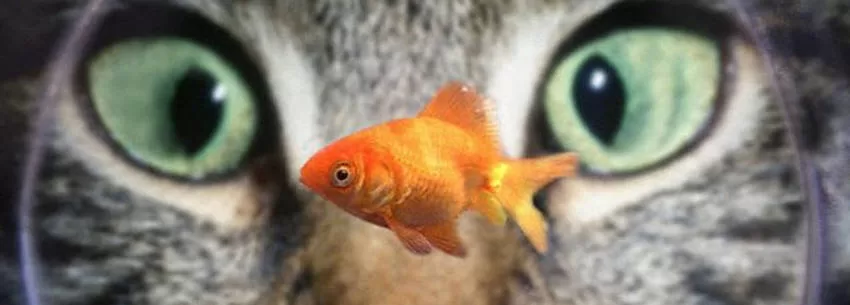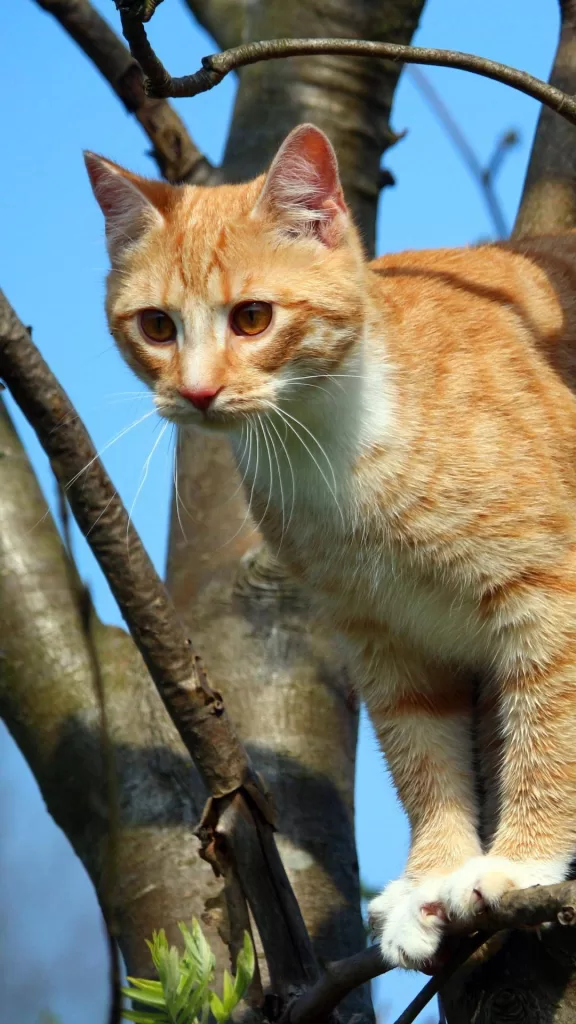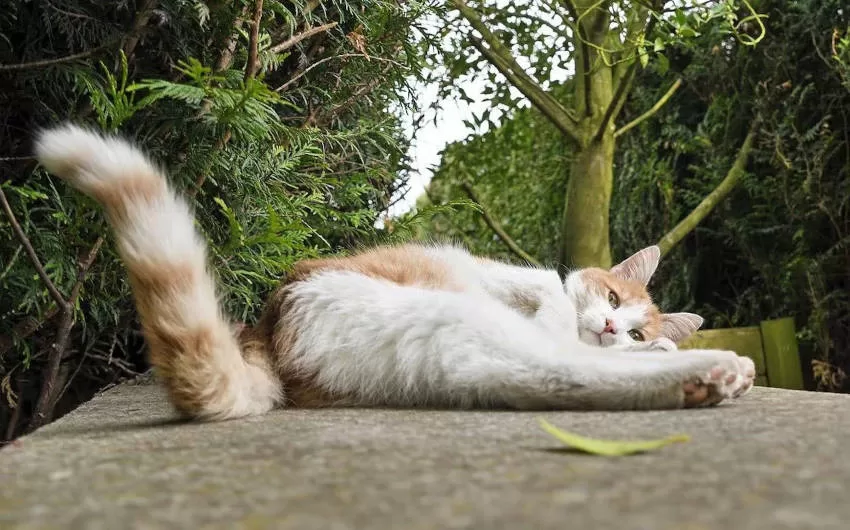Have you ever wondered how cats see the world? Vision is a vital part of any feline’s survival in the wild, and ophthalmology has a lot to teach us about that. However, perceiving the world through a cat’s eyes can be more challenging than it seems at first glance.
The ocular anatomy of cats is complex and differs significantly from ours. Whether day or night, rain or shine, they have unique visual abilities that help them navigate the world around them. But how exactly does this view work? And how does it compare to ours?
This article explains all of this in a timely and easy to understand way. So get ready to dive into the fascinating world of feline vision!
Cats and Colors: An In-Depth Analysis
Demystifying the Myth of Cats
Many cat owners believe that their feline friends only see the world in black and white. But, this is a wrong idea. According to a recent study, cats not only perceive colors, but also differentiate specific tones.
Cats see the world in shades of blue and green. They may not see all the colors of the rainbow like we humans do, but they definitely have a richer perception than just black and white.

Here is an example to illustrate:
- Imagine a red ball against a blue background.
- For humans, the ball will stand out clearly.
- For cats, the ball may appear darker against the blue background.
The Feline Color Spectrum
Now let’s dive into the spectrum of colors that cats actually perceive:
- Blue: Cats are very sensitive to shades of blue. They can distinguish various shades of this color.
- Green: Like blue, cats can also see various shades of green.
- Red: This is a color that cats suelen have difficulty identifying.
In summary, while we humans perceive the world in “RGB” (red, green and blue), cats see in “GB” (blue and green).
Colors Influencing Feline Behaviors
But why does it matter? Well, knowing what colors your cat can see can influence your decisions about toys or home decor.
For example:
- If you’re buying a new toy for your cat, choosing something in shades of blue or green might be more appealing to your cat.
- Likewise, if you’re considering painting your home and want something pet-friendly, consider using shades of these two colors.
Therefore, understanding how spenders see colors is not just a scientific curiosity – it can have real practical implications in the everyday lives of pet owners!

The Evolution of Vision in Felis Silvestris Catus
The Influence of Evolution on the Vision of Cats
Evolution played a crucial role in shaping the vision of domestic cats. If we look back at the evolutionary history of cats, we will see that they evolved primarily as nocturnal hunters. This led to specific adaptations in his vision.
An example of this is the high sensitivity to light. Cats have a special layer of cells, known as the tapetum lucidum, located behind the retina. This layer reflects light passing through the retina back through it, thus increasing the amount of light available to the photoreceptors and improving night vision.
Another adaptation is the large visual field of cats. They have a visual field of about 200 degrees, much larger than humans (about 180 degrees). This allows them to detect subtle movements around them – an essential skill when chasing mice in the dark!
Comparison Between the Visual Abilities of Different Feline Species
Visual abilities vary greatly between different feline species. For example:
- The snow leopard has excellent distance visual acuity – essential for locating prey in the vast mountain landscapes where it lives.
- In contrast, the Iberian lynx has large eyes and extremely dilated vertical pupils to maximize light gathering in dark forest environments.
However, all feline species share some common characteristics:
- They have more rods (light sensitive cells) than cones (cells responsible for detecting colors) in the retina.
- Their retinas also contain a high proportion of directional ganglion cells, which are sensitive to motion.
Specific Adaptations of Feline Vision for Hunting and Survival

Cats have several unique visual adaptations that help them with their daily activities:
- Night Vision : As mentioned earlier, cats are excellent at seeing in the dark. This is especially useful when chasing mice at night!
- Motion Detection : Cats are incredibly good at detecting small movements – another useful trait for a predator.
- Binocular Vision : The overlapping visual fields of the two eyes give cats good depth perception – vital when they are calculating precise jumps!
That concludes our look at how evolution has shaped the unique way cats see the world!
Curiosities of the Night Vision of Cats
How do cats see at night?
Cats’ eyes are true wonders of nature. They are designed to work very well in the dark, allowing these cats to see clearly even when light is scarce.
Unlike humans, cats have a special structure in their eyes called the tapetum lucidum. This layer reflects light back through the retina, thus increasing the amount of light available to the photoreceptors. This means that they see much better than we do in low light conditions.
Human night vision is quite limited. Our eyes lack the tapetum lucidum and we rely more on colors to see things around us. However, in darkness, our eyes struggle to distinguish colors and rely more on the contrast between light and dark.
Ambient light and nocturnal visual acuity of cats
The amount of ambient light can affect how cats see at night. In conditions of total darkness, even cats’ highly adapted eyes have difficulty seeing clearly. They need at least a little light to activate the tapetum lucidum.
But even in low light, they can still see better than us humans. Their eyes are able to quickly adjust to changing lighting conditions, allowing them to transition easily between light and dark areas.
However, that doesn’t mean they see everything perfectly at night. While its vision is superior to ours in low-light conditions, it’s still limited by the complete lack of color and fine detail.
Resuming:
- Cats can see well in the dark thanks to the tapetum lucidum in their eyes.
- Human night vision is limited by the lack of this ocular structure.
- The amount of ambient light affects the nocturnal visual acuity of cats.
- Even in low light, cats see better than us humans.
Understanding how cats see the world can help us better understand their behavior and their specific needs as predominantly crepuscular or nocturnal animals.
Feline Myopia: Possibility or Fiction?
Cat vision has always been an intriguing topic. Could they be myopic? This is a question many cat owners ask themselves. After all, how do cats see the world?
Cats and Myopia
Contrary to what many people think, cats do not have perfect eyesight. Some studies suggest they may be slightly myopic. This means that distant objects can appear a little blurry to them.
The potential symptoms of myopia in cats are subtle and can be easily confused with other health issues. However, some telltale signs include:
- Difficulty identifying objects at a distance
- Tendency to bump into furniture or walls
- Reluctance to jump to high places
If you notice any of these symptoms in your feline, it is recommended to look for a veterinarian specialized in animal ophthalmology.
Treating Feline Myopia
When it comes to the treatment of feline myopia, your options are limited. There are no glasses or contact lenses designed specifically for cats. However, there are some alternatives available:
- Laser Therapy: This procedure can correct the curvature of the cornea and improve your feline’s vision.
- Refractive surgery: Although it is a more invasive option, it can provide long-lasting results.
- Medication: In some cases, specific medications can help manage symptoms associated with myopia.
It is important to remember that each case is unique and the best treatment should be determined by your veterinarian based on your cat’s specific condition.
In short, although there is still much debate about the visual capacity of our feline friends, it is possible that they can suffer from myopia like us humans. So if you suspect an eye problem in your kitty, don’t hesitate to seek professional help.
Understanding how cats see the world allows us to take better care of them and ensure their quality of life. After all, who doesn’t want the best for their furry companion?

Comparison between Human and Feline Visions
Visual Perception Differences
The way cats see the world is very different from humans. Cats’ visual abilities are adapted to meet the specific needs of their lifestyle.
Cats’ eyes have more light-sensitive cells, allowing them to see better in the dark. In addition, they have a wider field of view than we do – about 200 degrees, compared to 180 degrees for people.
On the other hand, human vision surpasses that of cats in terms of color perception. While we can distinguish a wide range of hues, animals mostly see in blue and yellow.
Interacting with Pets
These differences in visual perception can affect our interaction with our pets. For example:
- Night Play: Cats love to play at night when their eyesight is at its best.
- Colorful Toys: Opt for toys in shades of blue and yellow to get your pet’s attention.
- Visual cues: Quick movements may be more noticeable to your cat than subtle changes in facial expression.
Understanding these differences can help strengthen the bond between owner and pet.
Myths about Animal Vision
There are several myths about how animals see the world. A common misconception is that all animals see in black and white. In reality, many species have some ability to perceive color – although not in the same way as humans.
Another myth is that animals have an almost supernatural night vision. While it is true that many species are adapted to see well in the dark, this does not mean that they can see in the complete absence of light.
Therefore, as we consider how our pets see the world, we must remember that their visual experience will be different from ours – but no less rich or complex.
Impact of Feline Vision on Local Biodiversity
The Visual Predator
Cats are known for their predatory instinct, a role they play masterfully thanks to their keen visual sense. They see the world in a unique way, which allows them to be excellent hunters. The ability to detect subtle movements and differentiate contrasts is crucial to their survival and hunting success.
For example, in rural areas where cats are common, they can significantly affect the population of small rodents and birds. Their presence can drastically alter the balance of the local fauna, as they are capable of reducing or even eradicating some species.
Cats and Delicate Ecosystems
The presence of large cat populations also has indirect implications in delicate ecosystems. Loose domestic cats can become a threat to local biodiversity, especially on islands where native species are not adapted to deal with these predators.
A study carried out in New Zealand showed that domestic cats were responsible for the death of approximately 1.5 million birds per year in the country. This demonstrates how feline vision can have a direct and devastating impact on local biodiversity.
Minimizing Negative Impacts
However, there are preventative measures we can take to minimize these negative impacts:
- Owner education: informing them about the possible negative impacts their animals may have on the local fauna.
- Population Control: Neutering programs can help control the number of cats in urban areas.
- Restrictions on Outside Access: Preventing cats from roaming freely can limit their impact on local ecosystems.
These strategies not only protect our local wildlife, but also ensure the well-being of our feline friends. After all, who doesn’t want to live in a world where both birds and cats can thrive?
In short, understanding “how cats see the world” is crucial to understanding their role in local ecosystems and how we can act to minimize any potential negative impacts. By doing this, we are contributing to the conservation of our precious local biodiversity.

Conclusion: Deciphering the World of Cats
So, we delved into the feline universe and discovered a lot of cool things, right? Now you know that cats not only see colors differently than we do, but they also have incredible night vision. And look how interesting: they can even be myopic! But remember, these differences don’t make cats weird creatures. Rather, they are evolutionary adaptations that allow our furry friends to survive and thrive in their environment.
So, did you enjoy this trip through the world of cats? If you have any questions or want to know more about it, just send it to us! We’d love to help you understand your four-legged friends even better. So let’s go: share this post on social media and spread this knowledge around!
Common questions
Do cats see in black and white?
No, cats don’t see in black and white. They can perceive some colors, but the color palette they see is less vibrant than ours.
What is the maximum distance a cat can see?
Cats can usually focus well on objects up to a distance of about 6 meters. Also, they may have trouble seeing.
Do cats have night vision?
Yes! Cats have excellent night vision. This is due to the high amount of light-sensitive cells (rods) present in feline eyes.
Can my cat’s eyesight get worse with age?
Yes, just like us humans, cats can also experience vision changes with advancing age.
How can I tell if my cat is having vision problems?
Some signs may indicate problems with your pet’s vision: bumping into furniture or walls; difficulty finding food or water; change in behavior; between others. If you notice anything strange, take your friend to the vet.
External Links:
https://www.cats.org.uk/cats-blog/cat-eyesight-facts

